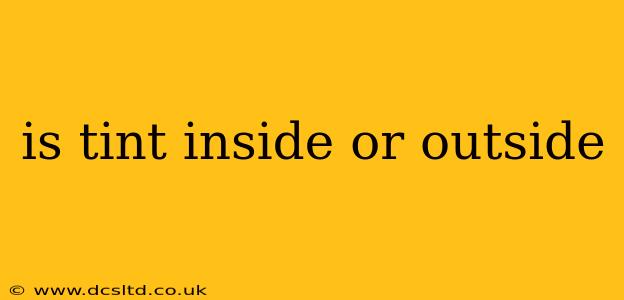The question of whether window tint goes on the inside or outside is a common one, and the answer isn't always straightforward. The best location depends on several factors, including the type of tint, your specific needs, and the climate where you live. Let's explore this further.
Where Should Window Tint Be Installed? Inside or Outside?
Generally, window tint is installed on the inside of the glass. This is the most common and recommended method for several key reasons:
- Protection from the elements: Exterior tint is more susceptible to damage from weather, including UV rays, extreme temperatures, hail, and even bird droppings. Inside application protects the film, extending its lifespan.
- Easier installation and maintenance: Installing tint on the inside is generally easier and less labor-intensive. Repairs and cleaning are also simpler.
- Safety and security: In the event of breakage, inside tint stays in place, reducing the risk of shattering glass causing further injury. Exterior tint could become a hazard if it shatters.
- Warranty considerations: Most window tint manufacturers warrant their products only when installed on the interior of the glass.
What About Exterior Window Tint? Are There Exceptions?
While less common, there are situations where exterior window tint might be considered:
- Specific film types: Some specialized films are designed for exterior application and can withstand the harsh elements. These are often used in commercial settings or for specialized applications like security film.
- Aesthetic preferences: In some rare cases, the desired aesthetic might necessitate exterior application. However, this should be carefully weighed against the increased risks.
It's crucial to note that exterior tint often requires professional installation due to the increased complexities and risks.
What are the pros and cons of inside vs outside window tint?
Here's a table summarizing the advantages and disadvantages of each installation method:
| Feature | Inside Tint | Outside Tint |
|---|---|---|
| Protection | Protected from elements | Exposed to elements |
| Installation | Easier, less labor-intensive | More difficult, labor-intensive |
| Maintenance | Easier to clean and repair | More difficult to clean and repair |
| Lifespan | Generally longer | Generally shorter |
| Safety | Safer in case of breakage | Potential safety hazard if broken |
| Warranty | Typically covered by warranty | May not be covered by warranty |
| Cost | Generally less expensive | Generally more expensive |
Can I install window tint myself?
While some people attempt DIY window tint installation, it's generally recommended to hire a professional. Professional installers have the experience and tools to ensure a flawless, bubble-free application and achieve optimal results. Improper installation can lead to premature failure of the film and void any warranty.
How long does window tint last?
The lifespan of window tint depends on several factors, including the quality of the film, the installation method, and environmental conditions. High-quality films properly installed on the inside can last for several years, sometimes even a decade or more. However, exterior tint will generally have a significantly shorter lifespan.
What type of window tint is best for my car or home?
The best type of window tint will depend on your specific needs and preferences. Factors to consider include:
- UV protection: All window tints offer some degree of UV protection, but the level varies.
- Heat rejection: Some tints are better at blocking heat than others.
- Privacy: The level of privacy offered by window tint also varies.
- Appearance: Tints come in various shades and levels of darkness.
Choosing the right tint and ensuring proper installation (typically inside) will maximize its benefits and longevity. Consult with a reputable window tinting professional to discuss your options and find the best solution for your specific needs.
